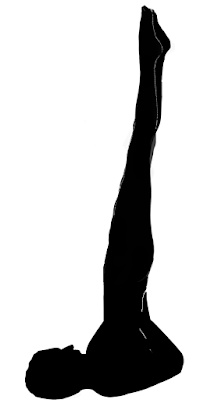Sarvangasana is one of the best yoga postures...
... but not for everyone, not for every time!
I am writing this post to caution yoga enthusiasts against doing asanas [=yogic exercises] that do not suit them, because I have seen reports of people hurting themselves after doing asanas and other yoga exercises the wrong way and then blaming Yoga for their problems.
Do not be carried away by the claims made by websites on yoga, even supposed to be maintained by yoga experts - when the claim looks exaggerated. I have seen many yoga 'experts' making unsubstantiated and highly exaggerated claims about some asanas, pranayamas and mudras. Some quote Sanskrit verses to give credence to their claims and some fabricate false stories of people getting amazing results after doing their course. I don't know how many of them do so for commercial gains. There could be some who are influenced by what they heard from others and want to share the wisdom on social networks and chat platforms for others' benefit. Unwittingly, they add their own imagination to the false stories.
Whatever the reason, such false claims lead to a predictable pattern: People looking for ways to shape up their bodies or get rid of a health issue fall for such claims. > They start doing the yogic activity using the same source or after watching a video on the web. > For some days, they get seem to get results, mostly due to their self-hypnosis/ placebo effect. > They look for even better results and start overdoing the exercises. > They get hurt but their bodies manage to cope with that. > They start getting hurtful symptom but they convince themselves that it is because the body is adjusting to the new activities. > The problem becomes big. > They leave the exercise altogether and blame yoga for their problems. They may also visit an allopathy doctor/ physiotherapist who reinforces their hypothesis that yoga harms rather than healing.
Sarvangasana and shirshasana
These two asanas are done with head down and feet up. Shirshasana is when you stand on your head and Sarvangasana is when you stand on your shoulders. Both these asanas work against the natural blood flow and suddenly raise blood pressure in arteries in the head. They also put unusually high pressure on the neck, which is one of the weakest parts of the body.
Shirshasana should be done only under the supervision of a real expert. It should be done slowly and for a short time. Age and overall heath condition are of paramount importance. So, say a big NO to learning it from websites and videos.
Sarvangasana is less risky than Shirshasana and one of the most beneficial yoga asanas. You can do it as mentioned here, with some help from the websites or videos of experts (including those issued by Indian AYUSH ministry).
In simple words, Sarvangasana is standing on one's shoulders. Lie down straight and raise legs till they are about 70-80 degrees up. Then slowly raise the entire body – the thighs, lower back and the upper back. When the body is upside down and resting on the shoulders, support the back with your bent arms.When starting to lift the body, exhale slowly and keep doing it till you stand on the shoulder. Inhale slowly and then take breath normally . Hold yourself in this position for half a minute and slowly come down to the lying posture, inhaling all the way. You can raise the holding time to three-four minutes if you feel comfortable.
Always remember to do Matsyasana [=fish posture] or Ushtrasan [=camel posture] after Sarvangasana. In these postures, you either lie down or sit with knees bent backwards, slowly lift your middle part of the body and support the posture with palms. These are counter-postures of Sarvangasana and either should be done for a maximum of one or two minutes.
Sarvangasana benefits
Savangasana [meaning, the exercise for the all organs] rejuvenates the entire body. Commonsense tell us that in this posture the neck is bent so much forward that the thyroid gland is pressed hard, blood flow reverses, the central nervous system bends and gets copious blood supply, and the muscles of shoulder, back and arms get to support the body's weight. Even if this asana did only this much good to the body, it has the potential of exercising the body’s circulatory, nervous and endocrine systems. But yoga-asanas are integrated exercises that help in many other ways – some of their benefits are being discovered by modern medicine through sophisticated instruments and diagnostic tools. Specific benefits of this asana [besides the overall health and rejuvenation] include increased metabolic activity, vanishing of fatigue, improved pancreatic, thyroid and sex-gland functions, reversal of hernia, improved liver and renal activity, facial glow and lessening of age-related wrinkles.
Sarvangasana: cautions
But sarvangasana is not for all. It should not be performed by people with high level of hypertension, any heart or brain ailment, weak lungs, spondylitis, back pain, glaucoma, detached retina, or bleeding of nose. Weak bodies should consult the doctor before performing this asana. If you are above 40 and not a yoga practitioner for long, avoid this asana. Even if you had been practicing it for ages, reduce its duration after around 50 years of age and consult a yoga expert. It is a no-no for pregnant women after three months of pregnancy. Sturdy people also should not do it when sick. Even if you are healthy in all senses, don't do it for more than 3-4 minutes, starting with about 30 seconds and slowly increasing it. If you feel flush of blood on your face, slowly come down and do not practice this asana for longer than this duration. Do not bend the body upwards or come back to the lying posture in a jerk.
